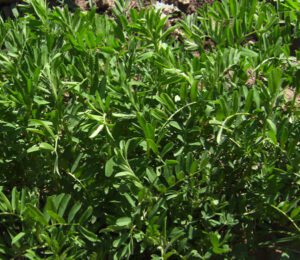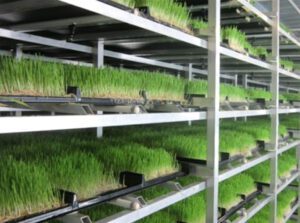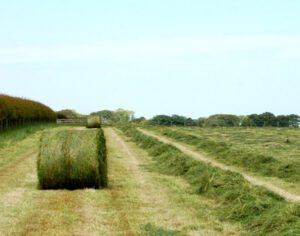Commercial chickpea farming is a very common and popular business in India. And it is the most important pulse crop of India. But it is also grown in some other countries around the world.
Chickpea is an annual legume of the family Fabaceae, subfamily Faboideae. It is generally used for human consumption as well as for feeding to animals. Fresh green leaves are used as vegetable while straw of chickpea is an excellent fodder for cattle. The grains are mainly used as vegetable where they are available. Main chickpea farming countries are India, Pakistan, Ethiopia, Burma and Turkey. India ranks first in total production among all these countries.
Chickpea is also known by many other different names in many different parts of the world. It’s other names include Chana, Bengal Gram, Chick Pea, Garbanzo, Garbanzo Bean, Egyptian Pea and simply as gram.[1]
Chickpeas are mainly used as human food and used in many different dishes. They are very high in protein and very good for human health. Chickpea is one of the earliest cultivated legumes, and 9500 year old remains have been found in the Middle East. Chickpea is a very important ingredient in the Mediterranean and Middle Eastern cuisines, when ground into flour, falafel.
Chickpea is also is an important in Indian cuisine and also used in salads, soups and stews, and curry, in chana masala, and in other meal products like channa. World production of chickpeas was 15 million tonnes in the year of 2020, led by India with 73 percent of the world total. And other major chickpea producing countries are Turkey, Myanmar and Pakistan.
Uses of Chickpea
Chickpea is mainly used as human food and it is a key ingredient in Mediterranean and Middle Eastern cuisines. It also very important in Indian cuisine. It is used in many different dishes, salads, soups, stews, curry and in chana masala. Chickpea also serve as an energy and protein source as animal feed in many areas. Chickpea is very healthy and good for human health. A 100 gram reference serving of cooked chickpeas provides 164 kilocalories of food energy. Cooked chickpeas are 3% fat, 9% protein, 27% carbohydrates and 60% water. 75% of the fat content is unsaturated fatty acids for which linoleic acid comprises 43% of the total fat.

Advantages of Chickpea Farming Business
Large scale or commercial chickpea farming has numerous benefits or advantages, like other crop farming business. It’s a very easy business and anyone can do it with little knowledge. Commercial or large scale chickpea farming is profitable and it can be a great income source for the people. Here we are trying to describe the top advantages or benefits of commercial chickpea farming business.
- Starting large scale chickpea farming is relatively easy and simple, even the beginners can start this business easily.
- Commercial chickpea farming is profitable. So it can be a good income source for the people.
- Large scale production of chickpea is a very old and established business, and many people are already growing chickpeas for making money.
- You don’t have to worry much about starting and operating this business, because many people are already doing this.
- Chickpea plants are very strong and hardy, and they grow very rapidly.
- The chickpea plants generally require less caring and other management. So, commercial chickpea production is relatively easy and simple.
- Both demand and value of chickpea are good in the market. So, profits will be good from commercial chickpea farming business.
- Marketing chickpeas and chickpea products is very easy. Because, both demand and value are good in the market.
- Commercial production of chickpea is very profitable, so it can be a great employment source for the people. Especially for the educated but unemployed people.
- Production costs in commercial chickpea farming is relatively less as compared to other crop farming business.
- Water and labor requirements are relatively less in commercial chickpea production.
- Chickpeas are very nutritious and good for human health. And you can enjoy fresh chickpeas if you start your own chickpea farming business.
How to Start Chickpea Farming?
Starting commercial chickpea farming business is very easy and simple. It’s just like starting other crop farming business. You can start this business easily even if you are a beginner. But, we recommend having practical experience from existing farmers before starting commercial chickpea farming business. Here we are trying to describe more information about chickpea farming business from planting, caring to harvesting and marketing.
Site Selection
Chickpeas grow well in a wide variety of soils. But these plants generally grow well in moderately heavy soils, black cotton soils and sandy loam soils. But sandy loam to clay loam soil with good fertility and good internal drainage system are most suitable for commercial chickpea farming. It will be better if the soil is not heavy alkaline in nature. Suitable pH range for commercial chickpea farming is between 5.5 and 7.
Prepare the Soil
Land preparation is very important for commercial chickpea farming business. Follow ideal land preparation tasks based on soil type and cropping system. Generally, 2-3 ploughing followed by 2 harrowing is necessary.
Climate Requirement For Chickpea Farming
Chickpea is basically a winter season crop and it can be cultivated under both irrigated and rainfed conditions. But they can not tolerate frost, especially during flowering stage. Annual rainfall between 65 cm and 95 cm is required for chickpea cultivation. And these plants generally grow well under good moisture conditions with ideal temperatures between 24°C and 30°C.
Choose a Variety
There are actually two main varieties of chickpeas available based on their size, color, thickness and shape of the seed. These two varieties are Desi chickpeas and Kabuli chickpeas. There are also many sub-varieties under these two main varieties. You can choose any variety depending on it’s availability in your area. Consult with your local farmer for more information.
Propagation
Propagation of chickpea is done through seeds.
Purchase Seeds
Chickpea seeds are easily available in the market. You can easily purchase the seeds from any of your nearest seed supply stores. Use seed rate of 15 to 18 kg per acre for Desi variety and around 37 kg per acre for Kabuli variety.
Planting/Sowing
Complete sowing from October 10 to October 25 for rainfed conditions. And complete sowing from October 25 to November 10 under irrigated condition. Seed should be spaced 10 cm apart allowing 30-40 cm between rows. And the seed should be placed 10-12.5 cm deep.
Caring
Chickpea plants generally require less caring and other management. Although, taking additional caring will help the plants to grow well and produce more. Here we are trying to describe more about the caring process of chickpea plants.
Fertilizing: Apply Nitrogen in form of Urea at a rate of 13 kg per acre and Phosphorus in form of Super Phosphate at a rate of 50 kg per acre at time of sowing for the Desi varieties for both irrigated and rainfed areas. Whereas apply Urea at a rate of 13 kg per acre and Super Phosphate at a rate of 100 kg per acre at time of sowing fir Kabuli varieties. Apply all the fertilizers and ensure they are drilled in furrows at a depth of 7-10 cm for efficient use of fertilizer.
Irrigation: Give a pre-sowing irrigation where irrigation facilities are available. Doing this will ensure proper germination and smooth crop growth. Then give second irrigation at the time of pre-flowering and next one at pod development stage. Delay irrigation in case of early rain and give according to requirement. Heavy and excess irrigation enhance vegetative growth and depress grain yield.
Controlling Weeds: Controlling weed from the field is very important, because weeds consume nutrients from the soil. Take first hand weeding or with wheel he 25-30 days after sowing and second if needed after 60 days of sowing. Simultaneously for effective weed control, pre-emergence application of Pendimethalin at the rate of 1Litre per 200Litre water on third day after sowing for one acre land. It will help for controlling annual weeds.
Pests & Diseases
Like many other commercial crops, the chickpea plants are susceptible to many pests and diseases. Here we are trying to describe about the most common pests and diseases of the chickpea plants.
Blight: Dark brown spot with dot like bodies develop on the stem, branches, leaflet and pods of the blight disease affected plant. Using resistant varieties will mostly help to prevent this disease. Carry out seed treatment with fungicide before sowing the seeds. If you notice the symptoms of this disease then spray with Indofil M-45 or Captan at a rate of 360 grams per 100 ltr of water per acre.
Gray Mold: Small water soaked spots are observed on leaflets. Carry out seed treatment before sowing for preventing this disease. If you observe infestation of this disease, spray crop with Carbendazim at a rate of 2 grams per liter of water.
Rust: Small, round to oval light or dark brown pustules are formed on the under surface of the leaves. Using rust resistant varieties will help to prevent this disease. If you notice the symptoms of this disease, spray the crop with Mancozeb 75 WP at a rate of 2 grams per liter of water. Give two more sprays with an interval of 10 days.
Wilt: Initially affected plant show dropping of petioles and gives dull green color. Afterwards all leaves turn yellow and become straw colored. Wilt disease causes considerable loss in yield. Growing wilt resistant varieties will help to prevent this disease. If you observe wilt in fields, then spray 300 ml Propiconazol with 200 liter of water per acre.
Cut Worm: Caterpillar remain hide in soil at depth of 2-4 inches. These worms cut at base of plant, branches or stem. Eggs are laid down in soil. Larva is dark brown with red head. Adopting crop rotation will help to prevent this disease. Use only well decomposed cow dung in the field. In case of severe infestation, spray with Profenophos 50EC at a rate of 600 ml per acre in 200-240 liters of water. But in case of low infestation spray Quinalphos 25EC at a rate of 400 ml per 200-240 liters water per acre.
Gram Pod Borer: Gram pod borer is the most serious pest of chickpea and it causes damage up to 75% reduction in total yield. These pests fed on leaves causes skeletonization of leaves, and also feeds on flower and green pods. Spray Emamectin Benzoate 5%SG at a rate of 7-8 grams per 15 liter or 20%WG Flubendiamide at a rate of 8 grams per 15 liter water, in case of severe infestation.
Termite: Termite feeds on root or near root zone of the crop, and the affected plant show symptom of drying up. Treating the seeds with Chlorpyriphos 20EC at the rate of 10ml per kg of seeds will help to protect the seeds from termite. Drench with Imidacloprid at the rate of 4ml per 10litre of water or Chlorpyriphos at the rate of 5ml per 10Ltr of water, if infestation occur in standing crop.
Harvesting
The crop become ready to harvest when the plants get dry and the leaves turn reddish brown and start shedding. Cut the plant with sickle for harvesting. Then sundry the harvested crop for 5-6 days. Carry out threshing (after proper drying) by beating the plants with sticks or by trampling under the feet of bullocks.
Grains of the harvested crop must be well dried before storage. And also take care to avoid the pulse beetle infestation in storage.
Yield
It’s very tough to tell the exact amount, because it depends on numerous factors (such as farm management practices, variety, irrigation etc.). But on an average you can expect an average yield of 2 to 3 tonnes per hectare.
Marketing
Marketing chickpeas is very easy and simple. You will probably be able to easily sell your products in the local market. Although, you should set your marketing strategies before starting this business.
These are the common steps and ways for staring and operating a successful chickpea farming business. Hope this guide has helped you! Good luck and may God bless you!





